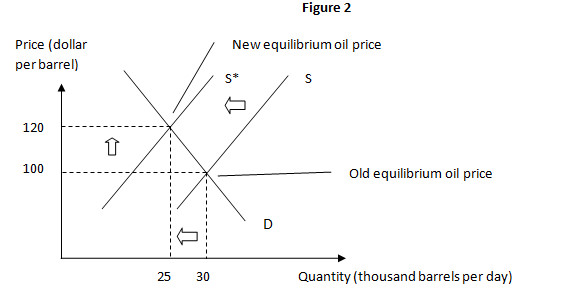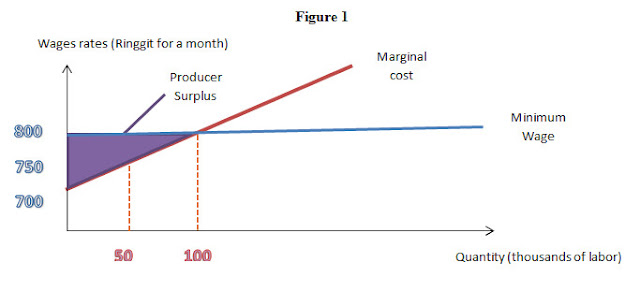The article posted by the famous magazine which
is Economist, (http://www.economist.com/blogs/freeexchange/2012/02/oil), discussed about the raises of oil price affected by either the low production of oil or sudden
growth of global demand for oil in America. The raises of oil price also
positively affect the firms’ quantity of labour demanded in the market. The
increases of oil price will increases the burden of American’s citizen income.
The first factor that increases the price of oil is
the high population in America. Nowadays, the quantity demanded for oil
increase because of the global population is increasing. The high population led
to high global demand for oil and result in the raises in oil price. This will
shift the oil demand curve in the market. From the figure 1, the equilibrium
price is $100 per barrel as well as equilibrium quantity of oil demanded is 18
million barrels per day. When the population in American increase, the demand
curve shifts rightward, while supply curve do not changes. The D* is the new
demand curve in the market. The shift of demand curve to the right shows the
increase in quantity demanded for oil from 18 to 19 million barrels per day. This
also increases the price of oil from $ 100 to $120 per barrel due to an old equilibrium
oil price shifts upward. Therefore, the population increase shift the demand
curve to the right results in the increasing of the quantity of oil demanded as
well as the raises in oil price.
The second factor that affects to price of oil is the
state of nature. Bad and dry weather causes the run dry of oil pipes in
American. This result in the supply of oil decreases. Since the low production of oil is occurred, the price
of oil tends to increase. In the law of change in supply, the supply of oil
decrease will increase the oil price. Meanwhile, the quantity of oil supplied
decreases in the market. From the figure 2 is showing that the supply of oil
curve will shift leftward because of the run dry of oil pipes. Normally, the
market equilibrium oil price is lies in $100 per barrel with the equilibrium
quantity of 30 thousand barrels per day. After the oil is running
dry in the oil pipes, the supply curve shift to the left because the natural
event decrease the oil production. Meanwhile, the new supply curve, S*, causes
the quantity of oil supplied decrease from 30 to 25 thousand barrels per day. Supply
curve shifts leftward along the demand curve causes the new equilibrium oil
price increase from $100 to $120 per barrel. Demand curve will not change in
this event. Hence, the supply of oil decreases due to the natural event
decrease the production of oil as well as increase the price of oil eventually.
In addition, the raise of oil price will not affect
much on the quantity demand for oil. According to the law of elasticity of
demand, quantity of oil demanded slightly decreases or increases, when the
price rises or falls due to the oil is a natural item. Therefore, the oil
demand curve is a highly inelastic demand but not perfectly. From the figure 3
demonstrates that the oil price raises up to $120 per barrel, but the quantity
demand just only drop by 1 thousand from 26 to 25 thousand barrel per day. Therefore, this graph shows the highly
inelastic demand for oil but not perfectly.
On the other hand, the raising of oil price is affecting
the firm’s quantity demand for labor in the market. The factor that increases
the firms’ quantity demand for labor is the price of the firms’ output
increases. In other words, the raise of oil price is the reason that firms
increase their quantity of labor demanded. This is because the raise of oil
price increases the value of marginal product of labor. For instances at the
beginning, a firm has 1 worker to produce 5 barrel of oil per day. If the firm
hires the second worker to produce 10 barrel of oil, thereby the marginal
produce of that worker is 5 barrel of oil. If the price of oil is $100 per
barrel, the value of marginal product is $500 which is $100 times 5 barrel of
marginal oil. Meanwhile, if the wage rate is $20 per day, the firm earns the
profit of $480 from the second worker.
In this case, when the oil price raise up to $120 per
barrel, the value of marginal product of the second worker is $600 ($120 times
5 barrel of marginal oil). Therefore, the firm gains the extra profit of $580
which computed by the value of marginal product of second worker ($600) minus
the wage rate of $20 per day for the second worker. When the firm earned extra
profit, it intends to hire additional labor to produce additional produce. This
brings the profit to that firm when the additional products is produced and
sell it with higher price.
I believe that the
raising of the oil price brings benefit to those who are facing unemployment. The
firms are willing to hire additional labor to produce additional products in
order to gain extra profit. The extra profits reduce the total cost of the firms;
thereby it is deserve to employ more workers in the production. Therefore, the
increasing of oil price result in the reducing in unemployment as well as
suppliers can earn the considerable profits.

















